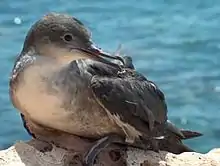Balearic shearwater
The Balearic shearwater (Puffinus mauretanicus) is a medium-sized shearwater in the seabird family Procellariidae. Puffinus is a New Latin loanword based on the English "puffin" and its variants, that referred to the cured carcass of the fat nestling of the Manx shearwater, a former delicacy.[2] The specific mauretanicus refers to Mauretania, an old name for an area of North Africa roughly corresponding to Morocco and Algeria.[3]
| Balearic shearwater | |
|---|---|
 | |
| Scientific classification | |
| Kingdom: | Animalia |
| Phylum: | Chordata |
| Class: | Aves |
| Order: | Procellariiformes |
| Family: | Procellariidae |
| Genus: | Puffinus |
| Species: | P. mauretanicus |
| Binomial name | |
| Puffinus mauretanicus P.R. Lowe, 1921 | |
| Synonyms | |
|
Puffinus puffinus mauretanicus | |
Taxonomy
The Balearic shearwater was long regarded a subspecies of the Manx shearwater. Following an initial split, it was held to be a subspecies of the "Mediterranean shearwater" for nearly ten more years,[4] until it was resolved to be a distinct species, separate from the yelkouan shearwater.[5][6][7] It is the last taxon of the Puffinus complex that was recognized as a separate entity.
It appears to belong to a group of Mediterranean and adjacent Atlantic species which includes the yelkouan shearwater[8] and one to three prehistorically extinct taxa, Hole's and possibly also Olson's shearwater and an undescribed form of unclear distinctness from Menorca.[9] Hole's shearwater may be the closest known relative of P. mauretanicus. The two living Mediterranean lineages had probably separated before the end of the Pliocene (c. 2 mya), as indicated by molecular differences and the Ibizan fossil Puffinus nestori from the Late Pliocene or Early Pleistocene, which may have been the direct ancestor of the present species.[6]
Description
This bird is approximately 33 cm (13 in) long, with an 85–90 cm (33–35 in) wingspan. It has the typically "shearing" flight of the genus, dipping from side to side on stiff wings with few wingbeats, the wingtips almost touching the water. This bird looks like a flying cross, with its wing held at right angles to the body, and it changes from dark brown to dirty white as the dark upperparts and paler undersides are alternately exposed as it travels low over the sea.
Apart from its less contrasting plumage, this species is very similar to the Manx and yelkouan shearwaters found elsewhere in the Mediterranean. At least one mixed breeding colony of Balearic and yelkouan shearwaters exists on Menorca, and the species' winter ranges overlap in the Central Mediterranean; for scientific purposes at least, a combination of morphological characteristics and DNA sequence data is suggested to identify the species.[10]
Habitat and range
This species breeds on islands and coastal cliffs in the Balearic islands. Most winter in that sea, but some enter the Atlantic in late summer, reaching north to Great Britain and Ireland.
Behaviour
This is a gregarious species, which can be seen in large numbers from boats or headlands, especially in autumn. It is silent at sea, but at night the breeding colonies are alive with raucous cackling calls, higher pitched than the Manx shearwater's.
Conservation and threats
The Balearic shearwater is considered critically endangered with extinction by the IUCN.[1] Recent models estimate a mean decrease of 7.4% per year and a mean extinction time of 40.4 years. This equates to an ongoing decline of more than 80% over the next three generations (54 years). It is under severe threat from the development of holiday resorts near its breeding sites. These can destroy or alter its natural breeding habitat by, for example, producing light pollution around nesting colonies.[12] Predation from introduced animals such as cats and rats also cause problems. The discovery of yelkouan shearwaters in the Menorcan colony suggests that hybridization may also pose a problem.[10]
References
- BirdLife International (2018). "Puffinus mauretanicus". IUCN Red List of Threatened Species. 2018: e.T22728432A132658315. Retrieved 1 November 2020.
- "Puffin". Oxford English Dictionary. Oxford University Press. Retrieved 14 December 2014.
- Jobling, James A. (2010). The Helm Dictionary of Scientific Bird Names. London, UK: Christopher Helm. p. 243. ISBN 978-1-4081-2501-4.
- Sibley, Charles Gald & Monroe, Burt L. Jr. (1990). Distribution and taxonomy of the birds of the world. New Haven, CT, USA: Yale University Press. ISBN 978-0-300-04969-5.
- Wink, Michael; Heidrich, Petra & Ristow, Dietrich (1993). "Genetic evidence for speciation of the Manx shearwater (Puffinus puffinus) and the Mediterranean Shearwater (P. yelkouan)" (PDF). Die Vogelwelt. 114 (6): 226–232.
- Heidrich, Petra; Amengual, José F. & Wink, Michael (1998). "Phylogenetic relationships in Mediterranean and North Atlantic shearwaters (Aves: Procellariidae) based on nucleotide sequences of mtDNA" (PDF). Biochemical Systematics and Ecology. 26 (2): 145–170. doi:10.1016/S0305-1978(97)00085-9.
- Sangster, George; Knox, Alan G.; Helbig, Andreas J.; Parkin, David T. (2002). "Taxonomic recommendations for European birds". Ibis. 144 (1): 153–159. doi:10.1046/j.0019-1019.2001.00026.x.
- Austin, Jeremy J. (August 1996). "Molecular Phylogenetics of Puffinus Shearwaters: Preliminary Evidence from Mitochondrial Cytochrome b Gene Sequences". Molecular Phylogenetics and Evolution. 6 (1): 77–88. doi:10.1006/mpev.1996.0060.
- Alcover, Josep Antoni (2001). "Nous avenços en el coneixement dels ocells fòssils de les Balears" (PDF). Anuari Ornitològic de les Balears (in Catalan). 16: 3–13.
- Genovart, Meritxell; Juste, Javier & Oro, Daniel (January 2005). "Two sibling species sympatrically breeding: a new conservation concern for the critically endangered Balearic shearwater". Conservation Genetics. 6 (4): 601–606. doi:10.1007/s10592-005-9010-z.
- Genovart, Meritxell (2016). "Demography of the critically endangered Balearic shearwater: the impact of fisheries and time to extinction" (PDF). Journal of Applied Ecology. 53 (4): 1158–1168. doi:10.1111/1365-2664.12622.
- Rodríguez, Airam; García, David; Rodríguez, Beneharo; Cardona, Esteban; Parpal, Lluís & Pons, Pere (October 2015). "Artificial lights and seabirds: is light pollution a threat for the threatened Balearic petrels?". Journal of Ornithology. 156 (4): 893–902. doi:10.1007/s10336-015-1232-3. hdl:10261/121510.
External links
| Wikimedia Commons has media related to Puffinus mauretanicus. |
- BTO BirdFacts - Balearic shearwater
- BirdLife species factsheet
- Flickr Field Guide Birds of the World Photographs
- Oiseaux
]
